Boston Marathon Bombing: Emergency Response and Communication Analysis
VerifiedAdded on 2021/06/17
|6
|1284
|18
Report
AI Summary
This report examines the multifaceted government response to the 2013 Boston Marathon bombing, analyzing communication strategies employed by local, state, and federal agencies, particularly the use of social media to disseminate information and engage the public. It details the care provided to the wounded, including the role of trauma centers, hospitalizations, and the rapid deployment of medical personnel. The report also highlights the significant challenges faced by first responders, such as supply shortages and the need for personal protective equipment. Furthermore, it evaluates the effectiveness of government actions, identifying both successful practices, like interagency cooperation, and areas where improvements could be made, such as enhancing weapon disciplines during law enforcement operations, and suggests ways to improve future emergency responses through better training and resource allocation.
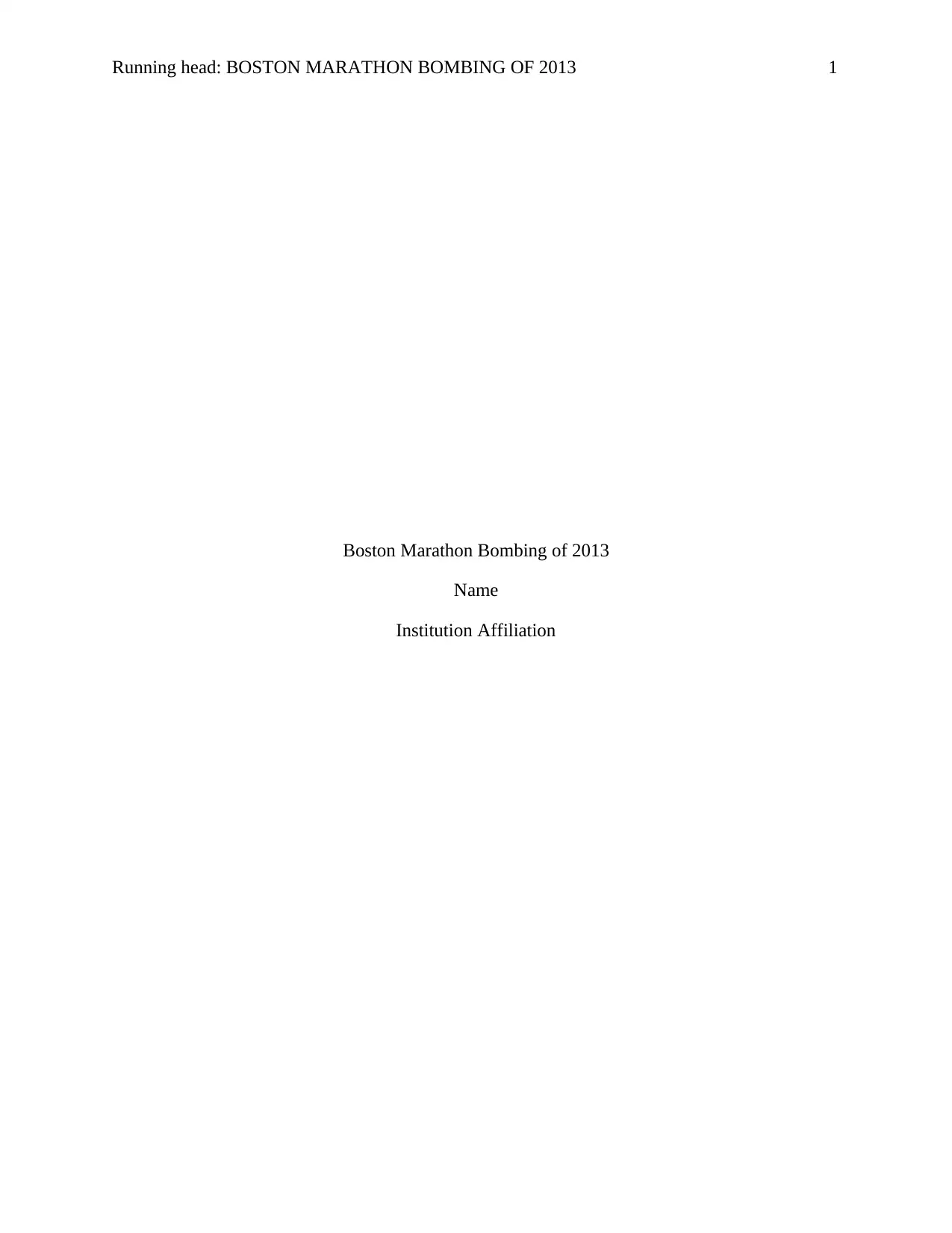
Running head: BOSTON MARATHON BOMBING OF 2013 1
Boston Marathon Bombing of 2013
Name
Institution Affiliation
Boston Marathon Bombing of 2013
Name
Institution Affiliation
Paraphrase This Document
Need a fresh take? Get an instant paraphrase of this document with our AI Paraphraser
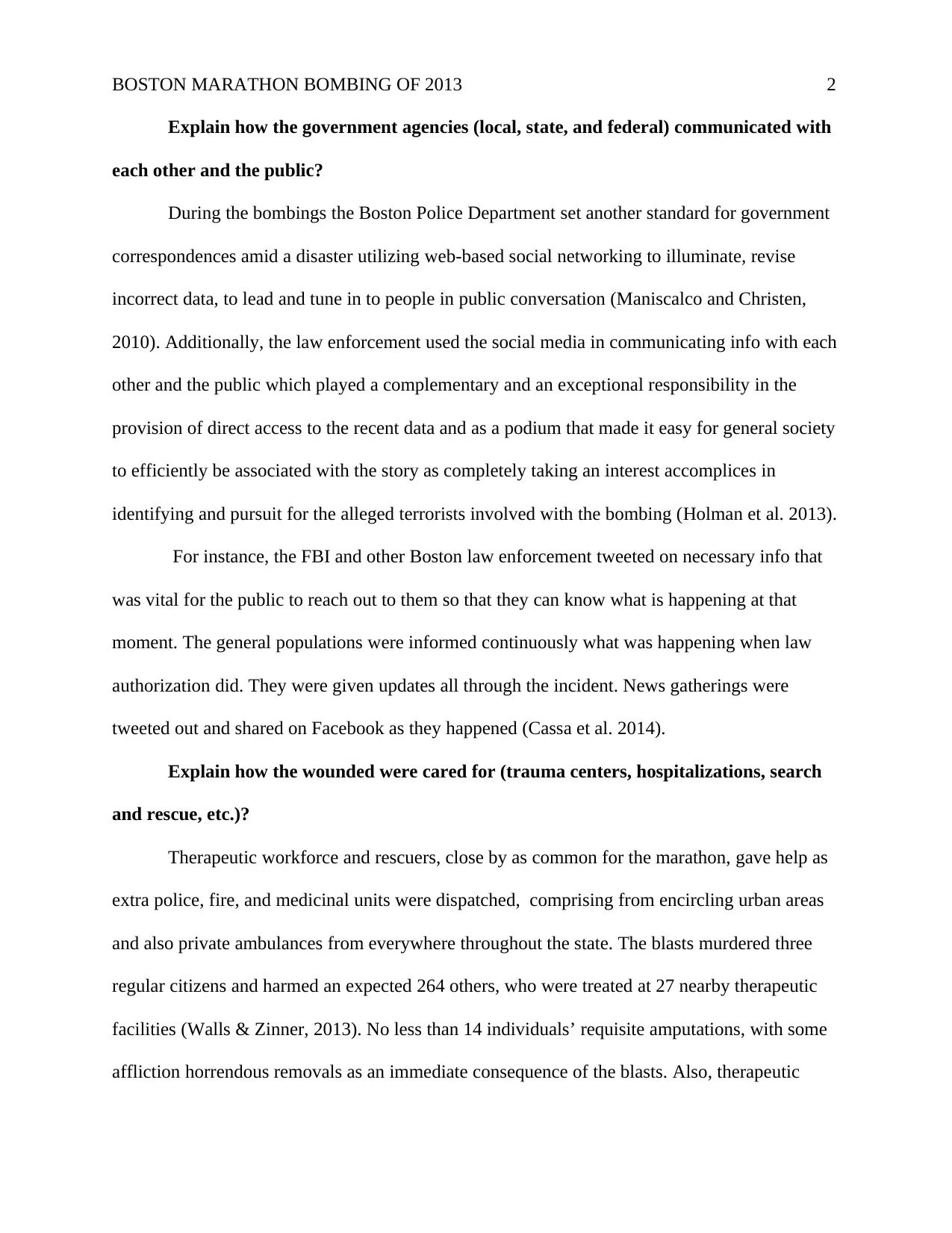
BOSTON MARATHON BOMBING OF 2013 2
Explain how the government agencies (local, state, and federal) communicated with
each other and the public?
During the bombings the Boston Police Department set another standard for government
correspondences amid a disaster utilizing web-based social networking to illuminate, revise
incorrect data, to lead and tune in to people in public conversation (Maniscalco and Christen,
2010). Additionally, the law enforcement used the social media in communicating info with each
other and the public which played a complementary and an exceptional responsibility in the
provision of direct access to the recent data and as a podium that made it easy for general society
to efficiently be associated with the story as completely taking an interest accomplices in
identifying and pursuit for the alleged terrorists involved with the bombing (Holman et al. 2013).
For instance, the FBI and other Boston law enforcement tweeted on necessary info that
was vital for the public to reach out to them so that they can know what is happening at that
moment. The general populations were informed continuously what was happening when law
authorization did. They were given updates all through the incident. News gatherings were
tweeted out and shared on Facebook as they happened (Cassa et al. 2014).
Explain how the wounded were cared for (trauma centers, hospitalizations, search
and rescue, etc.)?
Therapeutic workforce and rescuers, close by as common for the marathon, gave help as
extra police, fire, and medicinal units were dispatched, comprising from encircling urban areas
and also private ambulances from everywhere throughout the state. The blasts murdered three
regular citizens and harmed an expected 264 others, who were treated at 27 nearby therapeutic
facilities (Walls & Zinner, 2013). No less than 14 individuals’ requisite amputations, with some
affliction horrendous removals as an immediate consequence of the blasts. Also, therapeutic
Explain how the government agencies (local, state, and federal) communicated with
each other and the public?
During the bombings the Boston Police Department set another standard for government
correspondences amid a disaster utilizing web-based social networking to illuminate, revise
incorrect data, to lead and tune in to people in public conversation (Maniscalco and Christen,
2010). Additionally, the law enforcement used the social media in communicating info with each
other and the public which played a complementary and an exceptional responsibility in the
provision of direct access to the recent data and as a podium that made it easy for general society
to efficiently be associated with the story as completely taking an interest accomplices in
identifying and pursuit for the alleged terrorists involved with the bombing (Holman et al. 2013).
For instance, the FBI and other Boston law enforcement tweeted on necessary info that
was vital for the public to reach out to them so that they can know what is happening at that
moment. The general populations were informed continuously what was happening when law
authorization did. They were given updates all through the incident. News gatherings were
tweeted out and shared on Facebook as they happened (Cassa et al. 2014).
Explain how the wounded were cared for (trauma centers, hospitalizations, search
and rescue, etc.)?
Therapeutic workforce and rescuers, close by as common for the marathon, gave help as
extra police, fire, and medicinal units were dispatched, comprising from encircling urban areas
and also private ambulances from everywhere throughout the state. The blasts murdered three
regular citizens and harmed an expected 264 others, who were treated at 27 nearby therapeutic
facilities (Walls & Zinner, 2013). No less than 14 individuals’ requisite amputations, with some
affliction horrendous removals as an immediate consequence of the blasts. Also, therapeutic
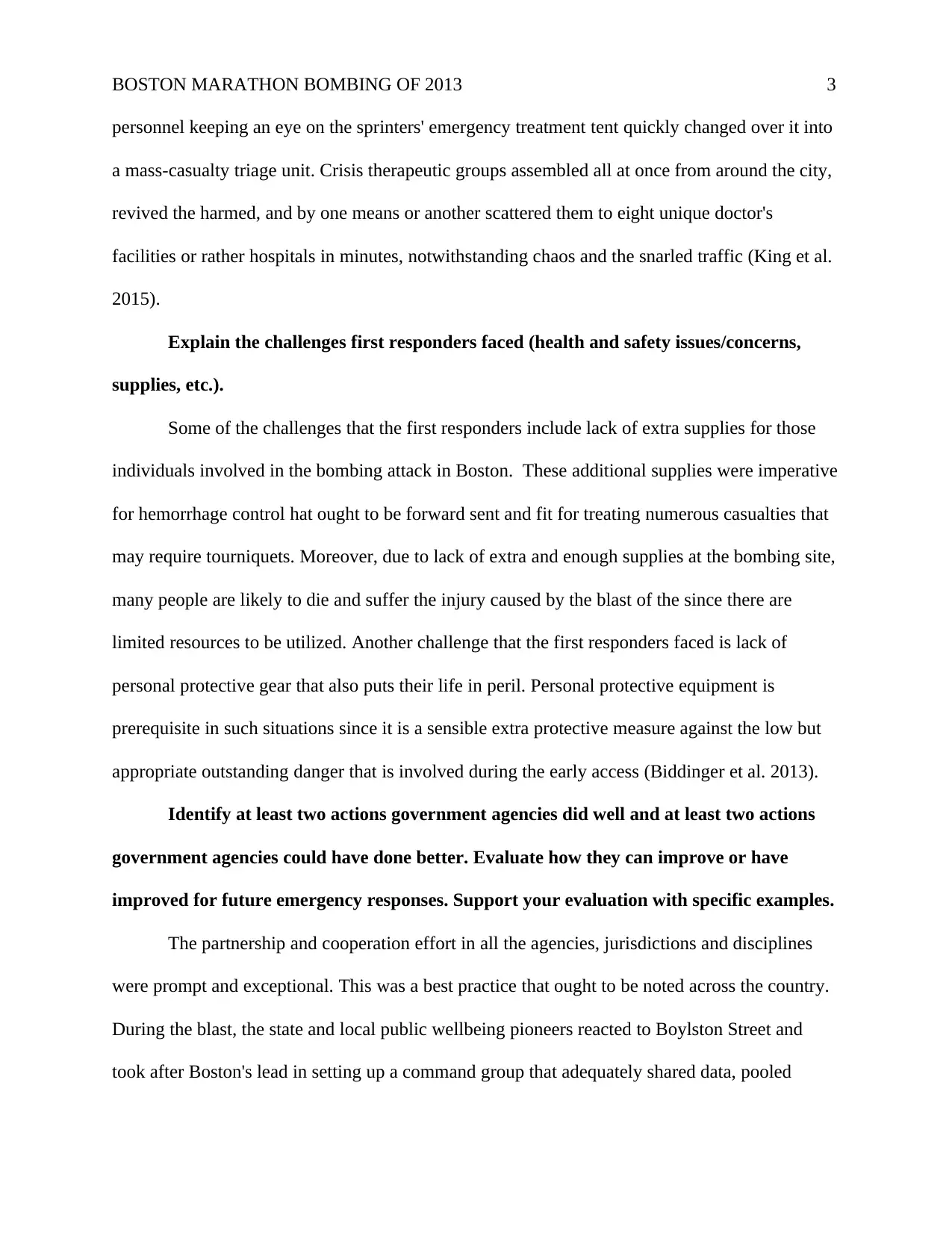
BOSTON MARATHON BOMBING OF 2013 3
personnel keeping an eye on the sprinters' emergency treatment tent quickly changed over it into
a mass-casualty triage unit. Crisis therapeutic groups assembled all at once from around the city,
revived the harmed, and by one means or another scattered them to eight unique doctor's
facilities or rather hospitals in minutes, notwithstanding chaos and the snarled traffic (King et al.
2015).
Explain the challenges first responders faced (health and safety issues/concerns,
supplies, etc.).
Some of the challenges that the first responders include lack of extra supplies for those
individuals involved in the bombing attack in Boston. These additional supplies were imperative
for hemorrhage control hat ought to be forward sent and fit for treating numerous casualties that
may require tourniquets. Moreover, due to lack of extra and enough supplies at the bombing site,
many people are likely to die and suffer the injury caused by the blast of the since there are
limited resources to be utilized. Another challenge that the first responders faced is lack of
personal protective gear that also puts their life in peril. Personal protective equipment is
prerequisite in such situations since it is a sensible extra protective measure against the low but
appropriate outstanding danger that is involved during the early access (Biddinger et al. 2013).
Identify at least two actions government agencies did well and at least two actions
government agencies could have done better. Evaluate how they can improve or have
improved for future emergency responses. Support your evaluation with specific examples.
The partnership and cooperation effort in all the agencies, jurisdictions and disciplines
were prompt and exceptional. This was a best practice that ought to be noted across the country.
During the blast, the state and local public wellbeing pioneers reacted to Boylston Street and
took after Boston's lead in setting up a command group that adequately shared data, pooled
personnel keeping an eye on the sprinters' emergency treatment tent quickly changed over it into
a mass-casualty triage unit. Crisis therapeutic groups assembled all at once from around the city,
revived the harmed, and by one means or another scattered them to eight unique doctor's
facilities or rather hospitals in minutes, notwithstanding chaos and the snarled traffic (King et al.
2015).
Explain the challenges first responders faced (health and safety issues/concerns,
supplies, etc.).
Some of the challenges that the first responders include lack of extra supplies for those
individuals involved in the bombing attack in Boston. These additional supplies were imperative
for hemorrhage control hat ought to be forward sent and fit for treating numerous casualties that
may require tourniquets. Moreover, due to lack of extra and enough supplies at the bombing site,
many people are likely to die and suffer the injury caused by the blast of the since there are
limited resources to be utilized. Another challenge that the first responders faced is lack of
personal protective gear that also puts their life in peril. Personal protective equipment is
prerequisite in such situations since it is a sensible extra protective measure against the low but
appropriate outstanding danger that is involved during the early access (Biddinger et al. 2013).
Identify at least two actions government agencies did well and at least two actions
government agencies could have done better. Evaluate how they can improve or have
improved for future emergency responses. Support your evaluation with specific examples.
The partnership and cooperation effort in all the agencies, jurisdictions and disciplines
were prompt and exceptional. This was a best practice that ought to be noted across the country.
During the blast, the state and local public wellbeing pioneers reacted to Boylston Street and
took after Boston's lead in setting up a command group that adequately shared data, pooled
⊘ This is a preview!⊘
Do you want full access?
Subscribe today to unlock all pages.

Trusted by 1+ million students worldwide
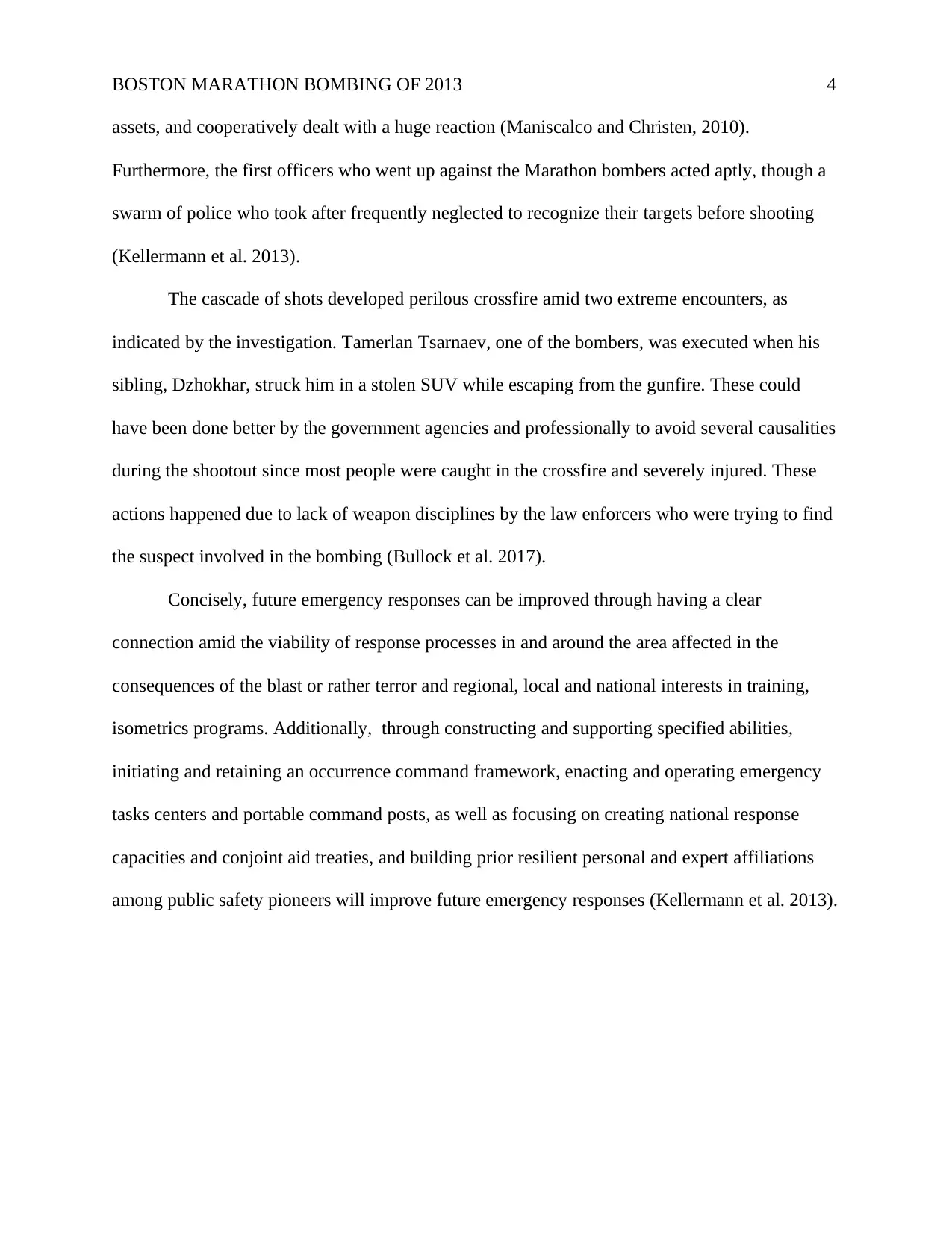
BOSTON MARATHON BOMBING OF 2013 4
assets, and cooperatively dealt with a huge reaction (Maniscalco and Christen, 2010).
Furthermore, the first officers who went up against the Marathon bombers acted aptly, though a
swarm of police who took after frequently neglected to recognize their targets before shooting
(Kellermann et al. 2013).
The cascade of shots developed perilous crossfire amid two extreme encounters, as
indicated by the investigation. Tamerlan Tsarnaev, one of the bombers, was executed when his
sibling, Dzhokhar, struck him in a stolen SUV while escaping from the gunfire. These could
have been done better by the government agencies and professionally to avoid several causalities
during the shootout since most people were caught in the crossfire and severely injured. These
actions happened due to lack of weapon disciplines by the law enforcers who were trying to find
the suspect involved in the bombing (Bullock et al. 2017).
Concisely, future emergency responses can be improved through having a clear
connection amid the viability of response processes in and around the area affected in the
consequences of the blast or rather terror and regional, local and national interests in training,
isometrics programs. Additionally, through constructing and supporting specified abilities,
initiating and retaining an occurrence command framework, enacting and operating emergency
tasks centers and portable command posts, as well as focusing on creating national response
capacities and conjoint aid treaties, and building prior resilient personal and expert affiliations
among public safety pioneers will improve future emergency responses (Kellermann et al. 2013).
assets, and cooperatively dealt with a huge reaction (Maniscalco and Christen, 2010).
Furthermore, the first officers who went up against the Marathon bombers acted aptly, though a
swarm of police who took after frequently neglected to recognize their targets before shooting
(Kellermann et al. 2013).
The cascade of shots developed perilous crossfire amid two extreme encounters, as
indicated by the investigation. Tamerlan Tsarnaev, one of the bombers, was executed when his
sibling, Dzhokhar, struck him in a stolen SUV while escaping from the gunfire. These could
have been done better by the government agencies and professionally to avoid several causalities
during the shootout since most people were caught in the crossfire and severely injured. These
actions happened due to lack of weapon disciplines by the law enforcers who were trying to find
the suspect involved in the bombing (Bullock et al. 2017).
Concisely, future emergency responses can be improved through having a clear
connection amid the viability of response processes in and around the area affected in the
consequences of the blast or rather terror and regional, local and national interests in training,
isometrics programs. Additionally, through constructing and supporting specified abilities,
initiating and retaining an occurrence command framework, enacting and operating emergency
tasks centers and portable command posts, as well as focusing on creating national response
capacities and conjoint aid treaties, and building prior resilient personal and expert affiliations
among public safety pioneers will improve future emergency responses (Kellermann et al. 2013).
Paraphrase This Document
Need a fresh take? Get an instant paraphrase of this document with our AI Paraphraser
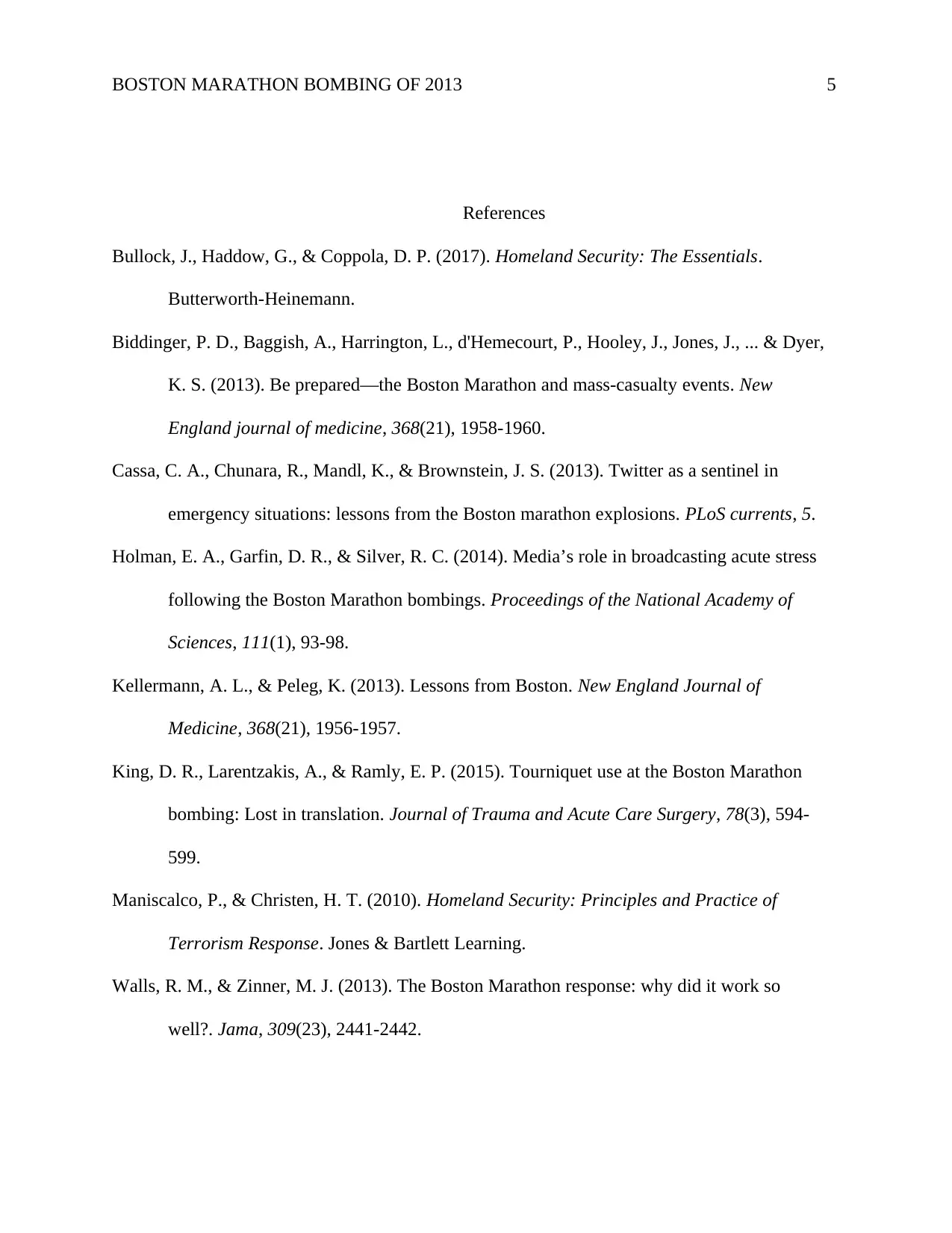
BOSTON MARATHON BOMBING OF 2013 5
References
Bullock, J., Haddow, G., & Coppola, D. P. (2017). Homeland Security: The Essentials.
Butterworth-Heinemann.
Biddinger, P. D., Baggish, A., Harrington, L., d'Hemecourt, P., Hooley, J., Jones, J., ... & Dyer,
K. S. (2013). Be prepared—the Boston Marathon and mass-casualty events. New
England journal of medicine, 368(21), 1958-1960.
Cassa, C. A., Chunara, R., Mandl, K., & Brownstein, J. S. (2013). Twitter as a sentinel in
emergency situations: lessons from the Boston marathon explosions. PLoS currents, 5.
Holman, E. A., Garfin, D. R., & Silver, R. C. (2014). Media’s role in broadcasting acute stress
following the Boston Marathon bombings. Proceedings of the National Academy of
Sciences, 111(1), 93-98.
Kellermann, A. L., & Peleg, K. (2013). Lessons from Boston. New England Journal of
Medicine, 368(21), 1956-1957.
King, D. R., Larentzakis, A., & Ramly, E. P. (2015). Tourniquet use at the Boston Marathon
bombing: Lost in translation. Journal of Trauma and Acute Care Surgery, 78(3), 594-
599.
Maniscalco, P., & Christen, H. T. (2010). Homeland Security: Principles and Practice of
Terrorism Response. Jones & Bartlett Learning.
Walls, R. M., & Zinner, M. J. (2013). The Boston Marathon response: why did it work so
well?. Jama, 309(23), 2441-2442.
References
Bullock, J., Haddow, G., & Coppola, D. P. (2017). Homeland Security: The Essentials.
Butterworth-Heinemann.
Biddinger, P. D., Baggish, A., Harrington, L., d'Hemecourt, P., Hooley, J., Jones, J., ... & Dyer,
K. S. (2013). Be prepared—the Boston Marathon and mass-casualty events. New
England journal of medicine, 368(21), 1958-1960.
Cassa, C. A., Chunara, R., Mandl, K., & Brownstein, J. S. (2013). Twitter as a sentinel in
emergency situations: lessons from the Boston marathon explosions. PLoS currents, 5.
Holman, E. A., Garfin, D. R., & Silver, R. C. (2014). Media’s role in broadcasting acute stress
following the Boston Marathon bombings. Proceedings of the National Academy of
Sciences, 111(1), 93-98.
Kellermann, A. L., & Peleg, K. (2013). Lessons from Boston. New England Journal of
Medicine, 368(21), 1956-1957.
King, D. R., Larentzakis, A., & Ramly, E. P. (2015). Tourniquet use at the Boston Marathon
bombing: Lost in translation. Journal of Trauma and Acute Care Surgery, 78(3), 594-
599.
Maniscalco, P., & Christen, H. T. (2010). Homeland Security: Principles and Practice of
Terrorism Response. Jones & Bartlett Learning.
Walls, R. M., & Zinner, M. J. (2013). The Boston Marathon response: why did it work so
well?. Jama, 309(23), 2441-2442.

BOSTON MARATHON BOMBING OF 2013 6
⊘ This is a preview!⊘
Do you want full access?
Subscribe today to unlock all pages.

Trusted by 1+ million students worldwide
1 out of 6
Your All-in-One AI-Powered Toolkit for Academic Success.
+13062052269
info@desklib.com
Available 24*7 on WhatsApp / Email
![[object Object]](/_next/static/media/star-bottom.7253800d.svg)
Unlock your academic potential
Copyright © 2020–2025 A2Z Services. All Rights Reserved. Developed and managed by ZUCOL.